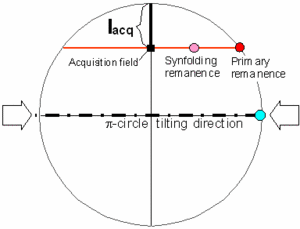Manuscripts and Comments
- small-circle_concept.pdf (1.5 MB): Original manuscript of the small-circle concept and reconstruction. Extract of the PHD-thesis "The Small-Circle Reconstruction and its Application to Palaeomagnetic Data from the Pamirs" (Waldhör 1999)
- small-circle_reconstruction.pdf (7 MB): Full thesis of Waldhör (1999). Small circle concept with paleomagnetic analysis and application to data from the Pamirs.
Four approaches to the palaeoinclination
There are the following possibilities to obtain the palaeoinclination from tilted remanences:
- Tilt correction of primary remanences
- Intersecting remanence small-circles
- Constraint from originally E-W tilted remanences
- Remanences with a known vertical-axis rotation (tilting back to known declination)
Tilt correction gives the palaeofield inclination independently from the axis of backtilting, but requires a pretilting (primary) remanence. The estimate from E-W tilted remanences is independent from the remanence character, but requires the tilt to have occurred around one horizontal axis without further displacements around other axes. Tilting back to a known declination and small circle intersections finally require also one horizontal tilt axis, no further tilts around other axes, and, in addition, no internal, relative rotations around vertical axes. In any case, remanences can only reveal what they experienced after acquisition. There is no use with 100% secondary, postfolding material.
1.: Tilt correction (many authors)
requires a primary character of the remanences and in this cases gives the best and most robust estimation. The other three options also work with secondary synfolding remanences.
2.: Intersecting small circles (Surmont et al. 1990, Shipunov 1999)

If no differential vertical-axis rotations (or other irregular relative displacements) occurred between the sites of a folded sequence or area, the palaeoinclination Iacq is given by the intersection of the remanence small circles (Shipunov 1997). The method is not restricted to directionally folded sequences, thus, can be applied to whole areas. However, the method requires sufficiently differing tilt directions and is highly sensitive to differential vertical-axis rotations. The problem is to find a number of sites without such contortions. Unfortunately, it seems that folded sequences perform vertical axis rotation to accommodate layers which are not parallel to the direction of shortening (Waldhör et al. 2001). Thus, all data sets have to be examined carefully if they really have the appropriate geometry. A tool to recognise relative displacements are small circle intersections.
3.: Estimate from E-W tilted remanences (Waldhör 1999, Waldhör et al. 2001)
The distance d between the great circle of bedding and the small circle of remanence is:
d = cos Iacq cos t
Iacq: field inclination at rem. acquisition, t: trend of horizontal tilt axis.
In the case of an originally E-W tilted site, t is 0°, we find:
d = cos Iacq , and Iacq = ±arccos |d|
thus, the angular distance d gives the inclination of the acquisition field. In practice, a statistical approach is required unless you know that no vertical axis rotations have occurred. The approach is relatively robust because of the cosine function of t, but requires appropriate sampling in the field. For details see entire manuscript (1.5 MB).
4.: Backtilting to known or assumed declination (Waldhör 1999, Waldhör et al. 2001)
If no originally E-W tilted remanences are available, an indirect approach is possible using an expected declination value (see Fig. right). If the vertical-axis rotation of a site is known, the remanence can be tilted back to the expected declination. The inclination is determined by the intersection of the remanence small-circle with the (half) great circle of constant declination. However, this method requires the relative rotation between involved sites to be negligible. With sites having low angular distances (tilted close to N-S), the Iacq-estimate is highly sensitive to variations of the expected declination. The approach can be helpful, but is probably restricted to specific cases.
Shipunov S.V. Synfolding magnetization: detection, testing and geological applications. Geophys. J. Int. 1997, 130, 405-410.
Waldhör, M. (1999). The Small-Circle Reconstruction in palaeomagnetism and its application to palaeomagnetic data from the Pamirs. Tübinger Geowissenschaftliche Arbeiten, Reihe A, Band 45, 99p.
Waldhör, M., Appel, E., Frisch, W. & Patzelt, A., 2001. Palaeomagnetic investigation in the Pamirs and its tectonic implications. J. Asian Earth Sci., 19, 429-451.
